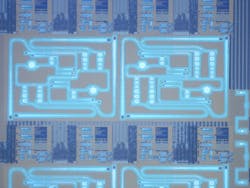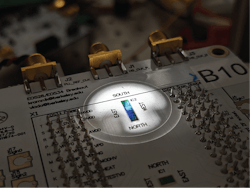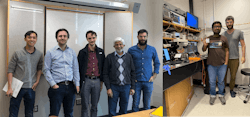Scientists create first electronic-photonic-quantum system on a chip
The world’s first electronic-photonic-quantum system on a chip, created by a group of scientists from Boston University (BU), the University of California Berkeley (UC Berkeley), and Northwestern University, combines quantum light sources and stabilizing electronics in a standard 45-nm semiconductor manufacturing process to generate streams of correlated photon pairs (see video).
Being able to do this within silicon is a big deal because “it shows we can build repeatable, controllable quantum systems in commercial semiconductor foundries,” says Miloš Popović, an associate professor of electrical and computer engineering at BU who led the collaboration.
Photon pairs generated by the group’s device can be used to build prototype quantum networks for distributing quantum information. One use is to implement discrete variable quantum key distribution (QKD) for secure communications. Importantly, the 1550-nm wavelength it uses is compatible with existing long-haul fiber infrastructure—where quantum and classical signals can potentially coexist on the same fiber.
And the interdisciplinary collaboration behind the electronic-photonic-quantum chip is precisely what’s needed to “move quantum systems from the lab to scalable platforms,” points out Prem Kumar, a pioneer of quantum optics and professor of electrical and computer engineering at Northwestern, whose group led the quantum characterization work.
A quantum holy grail: Scalability
One big challenge quantum technologies face today “is scalability rather than feasibility,” says Daniel Kramnik, at the time of the work a Ph.D. student at UC Berkeley who led the group’s chip, design, packaging, and integration in Professor Vladimir Stojanović’s group, and is now at GoogleX and pursuing a silicon photonics startup. “We see many proofs of concept of quantum technologies, but the difficult part is finding a way to scale them up so that quantum information systems can be made large enough to perform useful functions.”
Kramnik likens it to the difference between the first transistor in 1947 vs. the integrated circuits (ICs) developed during the ensuing decades that enabled computers to become useful and ubiquitous—and eventually spawned the internet, iPhone, and everything else that powers modern life. “One of the promising approaches to build scalable components for quantum hardware is silicon photonics, which uses CMOS-compatible manufacturing to build quantum systems based on manipulating light instead of matter,” he says.
Why CMOS manufacturing? It’s the most scalable way to build large systems—and it enables chips with billions of transistors to be manufactured. “If we could use it for quantum computers, it would provide a way to make them at the scale where they can perform useful tasks,” Kramnik explains.
Silicon photonic devices are sensitive to fabrication processes and temperature variations, which can cause them to display nonlinear effects that push the device off resonance and attenuate the efficiency of the quantum pair generation process. “Today, this is done with bulky off-chip components and lab equipment,” Kramnik says. “To truly make silicon photonics scalable for quantum information processing, we need a scalable way to combine the quantum, photonic, and electronic functions into a single CMOS-manufacturable device.”
The solution? Combine their group’s electronics-photonics integration expertise with quantum optics “to not only build the first such system but also do it within a commercial CMOS fab that currently does high-volume manufacturing with 45-nm resolution on radio-frequency silicon-on-insulator substrates—the 45RFSOI process—at GlobalFoundries,” Kramnik says. The collaboration leveraged expertise from Professor Kumar’s group, “which was the first to characterize and publish quantum-correlated photon-pair generation within silicon waveguides.”
While most research within this realm claims “CMOS-compatible” approaches to quantum photonics, it’s a quite a big deal to actually be within CMOS rather than merely compatible with CMOS manufacturing in principle.
Steady streams of quantum light
The group’s “quantum light factories” on a silicon chip—each <1 mm × 1 mm in dimension—rely on microring resonators to generate quantum states of light. These microring resonators are tuned in sync with incoming laser light that powers each of the tiny temperature-sensitive light factories. The challenge is to keep the devices in sync because not only are they sensitive to temperature but fabrication variations as well.
Each chip contains 12 microring resonator-based quantum light sources that operate in parallel and must stay synced with incoming laser light—despite potential for temperature drift and interference from nearby devices.
To stabilize them, the scientists rely on photodiodes inside the resonators to precisely monitor alignment with the wavelength of incoming laser—while preserving the efficacy of quantum light generation. Tiny on-chip heaters and control logic automatically adjust each microring’s resonance in response to drift. This part is essential to enable scaling up quantum systems.
“For any quantum measurements, we need to account for minute system losses to validate the model,” says Anirudh Ramesh, who was a Ph.D. student at Northwestern and led the group’s quantum measurement work and is now at PsiQuantum. “Closing in on the theoretical model with the measured data felt like a big achievement.”
And “observing the time evolution of the electronic digital-to-analog converter and analog-to-digital converter (DAC/ADC) codes, photonic (optical transmission) and quantum (photon-pair coincidences-to-accidentals ratio) parameters as the feedback controller determined a set point and stabilized the system, was pretty cool,” Ramesh adds. “It was tricky to orchestrate that measurement, but it gave us a unique perspective into calibrating a quantum photonic system.”
Off to the foundry
For their electronic-photonic-quantum chip design, the group draws photonic devices using the transistor CAD layers provided by the foundry, and then the foundry fabricates electronic circuits and photonic circuits on the same chip. “A suite of custom software developed in our research group translates the photonic designer’s intent to a combination of foundry CAD layers that’s also automatically adjusted to comply with the several thousand geometrical design rules needed for CMOS fabrication,” Kramnik explains.
Does the photonic chip work out of the box? Not so fast. To activate the photonic devices, they put the entire chip into a xenon difluoride (XeF2) etching machine to remove the silicon handle from the backside of the chip after it’s soldered to a PCB, and can then also couple light in and out of the waveguides and optical devices on the chip from the top side of the upside-down chip. It’s a process quirk that’s now unnecessary in GlobalFoundries’ new dedicated silicon-photonics-oriented volume manufacturing process—the 45SPCLO platform.
The group needed to optimize the photonic devices and electronic circuits to produce high-quality photon pairs rather than the usual high-speed data communication transceivers. “It required a detailed model and optimization of the nonlinear optics inside our devices,” says Imbert Wang, at the time of the work a Ph.D. student at BU who led the group’s photonic device design and integration work. “Circuits perform feedback control to calibrate and stabilize the production of photon pairs, which can be used to create a stream of heralded single photons—a key ingredient needed for many types of photonic quantum information systems.”
They also demonstrated a high-extinction optical filter “to separate these single photons from stray pump light on the same chip, another bulky off-chip component in many quantum optics experiments based on silicon photonics,” Wang adds.
Prototype quantum networks, pluggable fiber-optic quantum comms modules ahead
Photon pairs produced by the group’s devices are ready to build prototype quantum networks for distributing quantum information.
“We use a 1550-nm wavelength compatible with existing long-haul fiber infrastructure, and Professor Kumar’s group at Northwestern recently showed that quantum and classical signals can coexist on the same fiber via a quantum teleportation experiment,”1 says Kramnik. “Today, these networks are primarily used for research purposes to develop the communications infrastructure we’ll need in the future once useful quantum computers are ready.”
Another more immediate application is a pluggable fiber-optic quantum communication module based on the group’s chip for a quantum-secured network. “You can imagine certain government organizations and businesses would like to have laptops with 100% secure internet communications that can’t be snooped on like Wi-Fi or even Ethernet—a direct quantum connection to the end device through a fiber that attaches to a silicon-photonic chip would be one way to ensure it—even if you don’t own the fiber,” Kramnik says. “This may require further work on integrating III-V pump lasers and room temperature single-photon detectors onto the same chip, which have already been demonstrated in CMOS-compatible forms elsewhere.”
In the longer term, the group’s platform can be used to build large numbers of heralded single-photon sources needed for photonic quantum computers, such as the ones being pioneered by PsiQuantum and Xanadu.
“I’ve heard people say quantum technology is a solution looking for a problem,” says Wang. “The funny thing is the phrase ‘solution looking for a problem’ comes from a publication in 1964 describing the invention of the laser.2 Fast forward 60 years later, and lasers are used everywhere. A key to unlocking the potential of lasers was scaling their production. Now we have the ability to scale quantum light sources, and I’m really excited to find out what it enables for quantum tech.”
What’s next? Functionality
Not surprisingly, the group is already working on getting more functionality out of their chips. They recently published an OFC conference paper about using their photon-pair source to characterize timing drift within buried underground telecom fiber around the Chicago area.
“This study, surprisingly, shows that underground fiber over a long distance has less drift than a spool of fiber within the lab, which we attribute to the temperature being stabilized underground and any fluctuations (temperature, strain, etc.) being averaged out over the distance of the fiber—whereas the whole fiber is subject to the same variations when it’s concentrated in a spool in the lab,” says Ramesh.
Clearly, these quantum photon sources are already proving useful for engineering and science research for quantum networks. Chicago is a major hub of quantum internet research, and the group is “working on quantum interference experiments between multiple of our CMOS chips to show they can be used to create quantum entanglement between heralded single photons necessary for quantum information processing and networking. We also have a set of next-gen CMOS chips with improved photon-pair generation rate and more parts of the system integrated on the same chip we’re working on bringing up,” says Kramnik.
“Very-large-scale integration (VLSI) silicon photonics—with hundreds and thousands of photonic components tightly integrated with electronics—is now the focus of major industry efforts aimed at transitioning it into volume production, driven primarily by the needs of optical interconnects for AI hardware,” says Popović, who cofounded optical interconnect startup Ayar Labs in 2015 with Stojanović and several other current and former team members. “Quantum systems are even more sensitive and loss-bound than interconnects, so tapping into this industrial momentum is an opportunity to fast-track the development of larger quantum optical systems.”
Support for this work was provided by the National Science Foundation, including its Future of Semiconductors (FuSe) program, the Packard Fellowship for Science and Engineering, and the Catalyst Foundation, as well as Ayar Labs and GlobalFoundries.
FURTHER READING
D. Kramnik et al., Nat. Electron., 8, 620–630 (2025); https://doi.org/10.1038/s41928-025-01410-5.
REFERENCES
1. J. M. Thomas et al., Optica, 11, 1700-1707 (2024); https://doi.org/10.1364/optica.5403622.
2. C. S. Porter, “U.S. Army role in laser development, future potential discussed,” Army R&D News Magazine, 10 (Dec. 1964).
About the Author
Sally Cole Johnson
Editor in Chief
Sally Cole Johnson, Laser Focus World’s editor in chief, is a science and technology journalist who specializes in physics and semiconductors.




